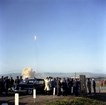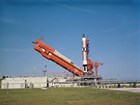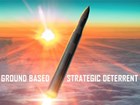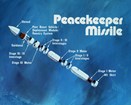Intercontinental Ballistic Missiles (ICBMs) were first deployed by the United States in 1959 and continue to be a critical weapon in the American nuclear arsenal today. ICBMs have ranges between 6,000 to 9,300 miles, making virtually any target in the world vulnerable. Due to their powerful and deadly nature ICBMs are considered a strategic defensive weapon. To learn more about the different types of ICBMs click on the links below.
-
Minuteman Missile National Historic Site
Article 1: The Atlas Missile

The Atlas was the United States first viable ICBM. From 1959-1965 it was deployed at many different Air Force Bases stretching from upper state New York all the way to New Mexico. Three different models of the Atlas, the D, E and F were put in the field. Each one was better than its predecessor, but due to the volatile nature of its liquid fuel the Atlas was retired only six year after coming online. Read more
-
Minuteman Missile National Historic Site
Article 2: The Titan Missile

The Titan was the largest ICBM ever deployed by the United States. Two versions of the Titan, the I and II were deployed from 1962-1987. The Titan I only lasted three years and was replaced by the much more advanced Titan II. The Titan held a nine megaton nuclear warhead, making it the most powerful single nuclear weapon in American history. Titans were finally retired in the mid-1980's due to their high cost and a series of accidents. Read more
-
Minuteman Missile National Historic Site
Article 3: The Minuteman Missile

The Minuteman was the first solid-fueled ICBM ever deployed. The Minuteman's solid fuel technology brought about a revolution in missile development. It could be remotely controlled, offered precision accuracy, launched in a matter of moments and was cost effective. There have been four versions of the Minuteman, the IA, IB, II and III. The Minuteman first became operational in 1962; over fifty years later, 400 Minuteman III ICBM's are still on alert today. Read more
-
Minuteman Missile National Historic Site
Article 4: The Peacekeeper [MX] Missile
The Peacekeeper [MX] missile was one of the most lethal and highly controversial ICBMs in history. It could hold up to ten nuclear warheads which could strike independent targets. The Peacekeeper was only deployed in Wyoming and housed in retrofitted Minuteman silos. The Peacekeeper also used solid fuel technology, which gave it all the advantages of the Minuteman, but with much greater potential firepower. It was deployed from 1987 until 2005. Read more
-
Minuteman Missile National Historic Site
Article 5: Ground Based Strategic Deterrent

The Ground Based Strategic Deterrent is a next generation intercontinental ballistic missile under development for the U.S. Air Force. Read more

